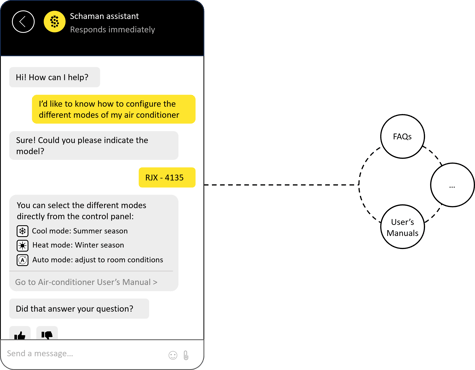Embracing generative AI: is it the new Customer Service revolution?
Generative AI (GenAI) has emerged in our daily lives in an abrupt way thanks to the ChatGPT phenomenon, transforming radically how we create. With GenAI we can generate texts, produce music, or even design new products using algorithms trained on existing data. This represents a paradigm shift in the productivity and potential of our own tasks and the processes of our organizations.
How does generative AI work?
Like any other artificial intelligence, GenAI works through machine learning (ML) models, previously trained on large amounts of data. These models can generate new instances of data by predicting what they should look like based on their prior understanding. Imagine "training" someone by showing them lots of pictures of bicycles and then asking them to draw a yellow bicycle.
Traditional ML models were discriminative. Their main objective was to determine the relationship between known and unknown factors. For example, when looking at pictures, they could identify known data such as the arrangement of lines, color, and shapes... and assign words (unknown factors) to them.
Generative models go one step further in the mapping of variables. Instead of predicting a label based on known features, they aim to predict new features based on given label ranges. Coming back to the bicycle example: generative models analyze images of bicycles to record different variables (handlebar shape, wheel size...). They are able to learn these features and the dissimilarities within them in order to recreate new bicycle images.
GenAI is shifting the job market
By training diverse ML models with large amounts of data, we can significantly reduce the burden of repetitive tasks, solve new problems, and make our ideas tangible, practically in real-time. Generative AI is changing practically every profession and our conception of work. It is a unique moment in which organizations and individuals must rethink how these algorithms can assist us by empowering our capabilities.
Many industries are already prepared to adopt this type of technology and benefit rapidly. For example, the financial services sector can relieve workers of repetitive tasks such as reviewing credit documentation, generic customer inquiries, or conducting market research. There are also cross-applications that can be adopted by almost any industry, such as the use of chatbots or virtual assistants that can be made available to customers or service agents themselves to provide a better agile and personalized experience.
The role of GenAI in customer service
Generating personalized responses in real-time or solving queries in an automated way while maintaining a human-like conversation, are some of the use cases that can already be covered by generative AI conversational chatbots. By using these virtual advisors we can not only improve operational efficiency but also scale the volume of interactions without losing the personalized treatment, covering a practically unlimited number of situations.
Schaman connects to the organization's knowledge databases and other static information of interest (procedures, faqs, manuals, datasheets...) to learn about it. Thanks to this training, it is able to generate answers based on the different user requests. Furthermore, Schaman is able to access various sources of information, business, and operation support systems such as the CRM, ERP, or billing system, to gather the necessary knowledge for understanding specific customer contact situations. With real-time access to this information, it becomes possible to fully contextualize each situation, enabling the resolution of both simple and complex interactions.
Once the information of interest is connected, we can configure the different experiences to be delivered through Schaman CX Designer. In addition, Schaman visual self-care offers the possibility to customize the bot to align it perfectly with the company's brand (colors, fonts, logos, conversation modes...). By combining the power of generative AI, Schaman’s data orchestration AI, and Schaman's visual, it is possible to deliver multiple applications. For example, an air conditioning installer company could connect Schaman to the various configuration manuals of its air conditioning portfolio to provide its installers with a "virtual expert" who could answer their questions about equipment configuration in real-time. Similarly, it could offer its end customers 24x7 support through a conversational bot capable of understanding the user's question and providing an answer.

In short, there is a broad landscape to leverage the use of GenAI. These use cases are slowly penetrating into companies and the rest of the companies that are not doing it should rethink when to enter, with which use cases, and how to do it in order to not be left behind.
Related posts
Generative AI Sounds Great, But It's Not What You Imagine
When we hear about Generative Artificial Intelligence, we often picture futuristic scenarios with robots speaking like humans or [...]The power of root-cause customer service for a proactive approach
Customer service remains a cornerstone for any business. The growing expectation of consumers to have their problems seamlessly solved [...]Stay tuned to receive new content
Schaman Customer Experience Spain, S.L. © 2025







